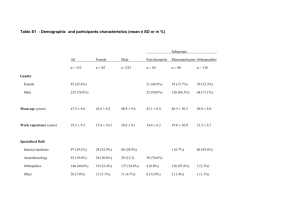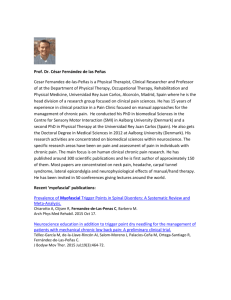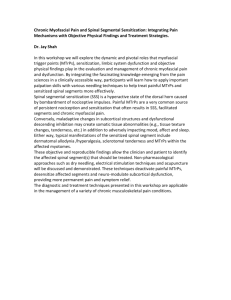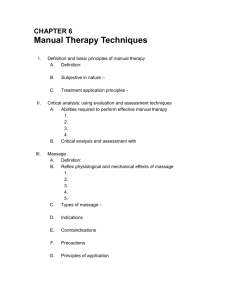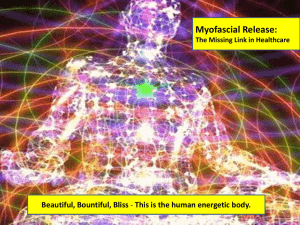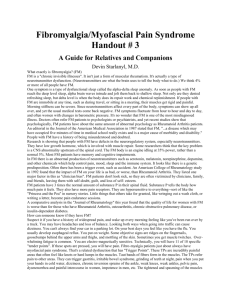Dr. Jay Shah Senior staff physiatrist in the Rehabilitation Medicine
advertisement
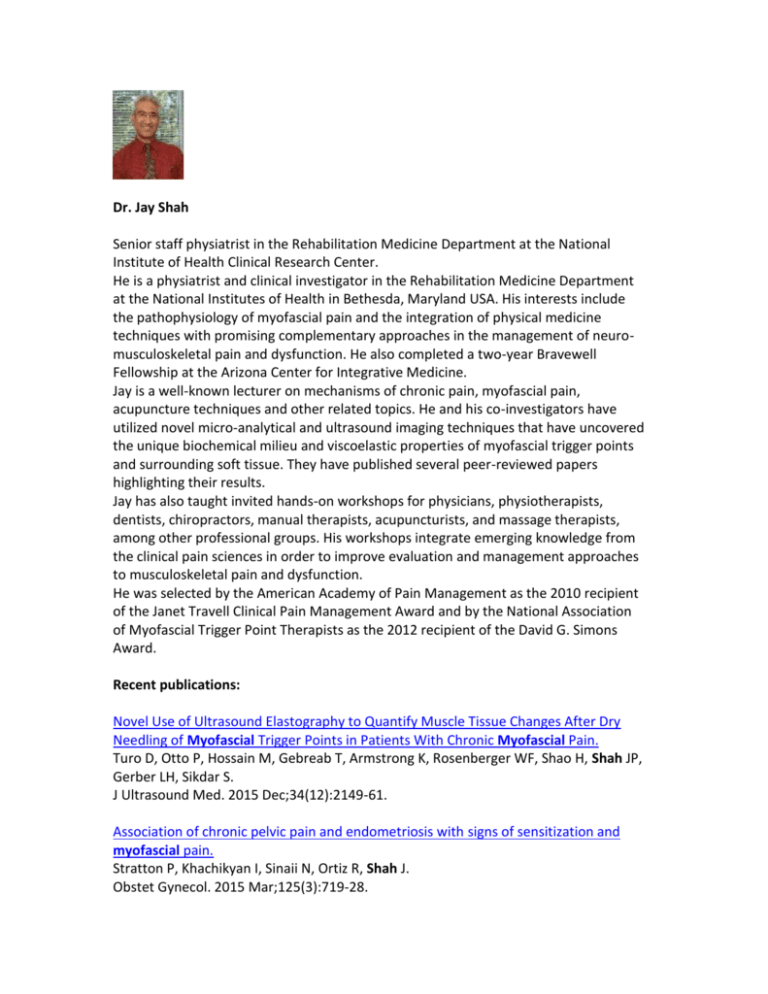
Dr. Jay Shah Senior staff physiatrist in the Rehabilitation Medicine Department at the National Institute of Health Clinical Research Center. He is a physiatrist and clinical investigator in the Rehabilitation Medicine Department at the National Institutes of Health in Bethesda, Maryland USA. His interests include the pathophysiology of myofascial pain and the integration of physical medicine techniques with promising complementary approaches in the management of neuromusculoskeletal pain and dysfunction. He also completed a two-year Bravewell Fellowship at the Arizona Center for Integrative Medicine. Jay is a well-known lecturer on mechanisms of chronic pain, myofascial pain, acupuncture techniques and other related topics. He and his co-investigators have utilized novel micro-analytical and ultrasound imaging techniques that have uncovered the unique biochemical milieu and viscoelastic properties of myofascial trigger points and surrounding soft tissue. They have published several peer-reviewed papers highlighting their results. Jay has also taught invited hands-on workshops for physicians, physiotherapists, dentists, chiropractors, manual therapists, acupuncturists, and massage therapists, among other professional groups. His workshops integrate emerging knowledge from the clinical pain sciences in order to improve evaluation and management approaches to musculoskeletal pain and dysfunction. He was selected by the American Academy of Pain Management as the 2010 recipient of the Janet Travell Clinical Pain Management Award and by the National Association of Myofascial Trigger Point Therapists as the 2012 recipient of the David G. Simons Award. Recent publications: Novel Use of Ultrasound Elastography to Quantify Muscle Tissue Changes After Dry Needling of Myofascial Trigger Points in Patients With Chronic Myofascial Pain. Turo D, Otto P, Hossain M, Gebreab T, Armstrong K, Rosenberger WF, Shao H, Shah JP, Gerber LH, Sikdar S. J Ultrasound Med. 2015 Dec;34(12):2149-61. Association of chronic pelvic pain and endometriosis with signs of sensitization and myofascial pain. Stratton P, Khachikyan I, Sinaii N, Ortiz R, Shah J. Obstet Gynecol. 2015 Mar;125(3):719-28. Myofascial Trigger Points Then and Now: A Historical and Scientific Perspective. Shah JP, Thaker N, Heimur J, Aredo JV, Sikdar S, Gerber L. PM R. 2015 Jul;7(7):746-61. Dry Needling Alters Trigger Points in the Upper Trapezius Muscle and Reduces Pain in Subjects With Chronic Myofascial Pain. Gerber LH, Shah J, Rosenberger W, Armstrong K, Turo D, Otto P, Heimur J, Thaker N, Sikdar S. PM R. 2015 Jul;7(7):711-8. A systematic comparison between subjects with no pain and pain associated with active myofascial trigger points. Gerber LH, Sikdar S, Armstrong K, Diao G, Heimur J, Kopecky J, Turo D, Otto P, Gebreab T, Shah J. PM R. 2013 Nov;5(11):931-8. Ultrasonic characterization of the upper trapezius muscle in patients with chronic neck pain. Turo D, Otto P, Shah JP, Heimur J, Gebreab T, Zaazhoa M, Armstrong K, Gerber LH, Sikdar S. Ultrason Imaging. 2013 Apr;35(2):173-87. Ultrasonic tissue characterization of the upper trapezius muscle in patients with myofascial pain syndrome. Turo D, Otto P, Shah JP, Heimur J, Gebreab T, Armstrong K, Gerber LH, Sikdar S. Conf Proc IEEE Eng Med Biol Soc. 2012;2012:4386-9. Office-based elastographic technique for quantifying mechanical properties of skeletal muscle. Ballyns JJ, Turo D, Otto P, Shah JP, Hammond J, Gebreab T, Gerber LH, Sikdar S. J Ultrasound Med. 2012 Aug;31(8):1209-19. PMID: 22837285 Objective sonographic measures for characterizing myofascial trigger points associated with cervical pain. Ballyns JJ, Shah JP, Hammond J, Gebreab T, Gerber LH, Sikdar S. J Ultrasound Med. 2011 Oct;30(10):1331-40. PMID: 21968483 Understanding the vascular environment of myofascial trigger points using ultrasonic imaging and computational modeling. Sikdar S, Ortiz R, Gebreab T, Gerber LH, Shah JP. Conf Proc IEEE Eng Med Biol Soc. 2010;2010:5302-5. Novel applications of ultrasound technology to visualize and characterize myofascial trigger points and surrounding soft tissue. Sikdar S, Shah JP, Gebreab T, Yen RH, Gilliams E, Danoff J, Gerber LH. Arch Phys Med Rehabil. 2009 Nov;90(11):1829-38. Assessment of myofascial trigger points (MTrPs): a new application of ultrasound imaging and vibration sonoelastography. Sikdar S, Shah JP, Gilliams E, Gebreab T, Gerber LH. Conf Proc IEEE Eng Med Biol Soc. 2008;2008:5585-8. Uncovering the biochemical milieu of myofascial trigger points using in vivo microdialysis: an application of muscle pain concepts to myofascial pain syndrome. Shah JP, Gilliams EA. J Bodyw Mov Ther. 2008 Oct;12(4):371-84. New views of myofascial trigger points: etiology and diagnosis. Simons DG. Arch Phys Med Rehabil. 2008 Jan;89(1):157-9. Biochemicals associated with pain and inflammation are elevated in sites near to and remote from active myofascial trigger points. Shah JP, Danoff JV, Desai MJ, Parikh S, Nakamura LY, Phillips TM, Gerber LH. Arch Phys Med Rehabil. 2008 Jan;89(1):16-23. An in vivo microanalytical technique for measuring the local biochemical milieu of human skeletal muscle. Shah JP, Phillips TM, Danoff JV, Gerber LH. J Appl Physiol (1985). 2005 Nov;99(5):1977-84. An expansion of Simons' integrated hypothesis of trigger point formation. Gerwin RD, Dommerholt J, Shah JP. Curr Pain Headache Rep. 2004 Dec;8(6):468-75. Review.
